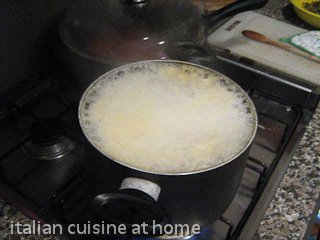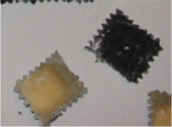ITALIAN RECIPES TRADITIONAL AND CREATIVE HOW TO COOK PASTA AND homemade pasta. As seen in the prior table the egg pasta generally contains common wheat flour, while the dough with water and flour is in general of durum wheat of semolina flour. This influences both the conservation and the cooking time. As seen in the prior table the egg pasta generally contains common wheat flour, while the dough with water and flour is in general of durum wheat of semolina flour. This influences both the conservation and the cooking time.
The eggs pastas generally are eaten fresh, alternatively they can be frozen, while the pastas made with water and flour are conserved by drying. Of course they can be consumed fresh. That means that egg pasta requires a shorter cooking time, generally 1 up to 3 minutes, while the semolina pasta can require a cooking time up to 8 minutes long, depending from thickness and drying level. For the “immersion cooking” generally we consider 2 pints (1lt) of water and 2 Lbs (1 kg) of pasta.  Pay attention to the pot dimension, the pasta needs place for not becoming sticky! Furthermore the fresh pasta foams as soon as boils, so use big pots and fill them only for the 70%. In this manner you avoid it to overflow. Use the same proceeding you use for boiling the milk. Pay attention to the pot dimension, the pasta needs place for not becoming sticky! Furthermore the fresh pasta foams as soon as boils, so use big pots and fill them only for the 70%. In this manner you avoid it to overflow. Use the same proceeding you use for boiling the milk.
The oven cooking manners are 2: traditional, with the goal of blending the stuffing ingredients, and au gratin. The first one is slow (20/40 minutes)  and generally about F° 280 ( C° 140) for not drying the pasta, the second one is quicker (3/5 minutes) at about F° 390 (C°200) for making the cheeses melt and making a crispy surface. Often both cooking manners are combined: a first separated cooking for the ingredients and then the final cooking all together. and generally about F° 280 ( C° 140) for not drying the pasta, the second one is quicker (3/5 minutes) at about F° 390 (C°200) for making the cheeses melt and making a crispy surface. Often both cooking manners are combined: a first separated cooking for the ingredients and then the final cooking all together.  For the condiments ( that have as the sole limit our fantasy…) a separated comment is due to the “stuffed pasta” as ravioli, tortellini, and cannelloni, where the condiment is already inside the pasta. In this situations we suggest a light sauce or simply a little extra virgin olive oil or fried butter and sage with shredded parmesan or pecorino cheese. In this manner you don’t cover the stuffing with new smells and flavors. For the condiments ( that have as the sole limit our fantasy…) a separated comment is due to the “stuffed pasta” as ravioli, tortellini, and cannelloni, where the condiment is already inside the pasta. In this situations we suggest a light sauce or simply a little extra virgin olive oil or fried butter and sage with shredded parmesan or pecorino cheese. In this manner you don’t cover the stuffing with new smells and flavors.
For cooking in broth it is always important cooking the pasta “al dente”! So it is important to add it to the broth just before serving and never store soups containing pasta already cooked inside. For the recipes go to first course pasta page where you can find some idea and also suggestions for the long pasta "management". << go to the kinds of pasta list
go to the home page
|